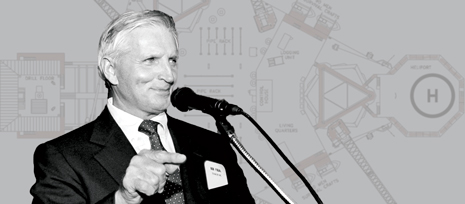Innovative thinkers
Bob Fogal:
The mind behind the past, present and future of offshore rig design
|
Bob Fogal
The mind behind the past, present and future of offshore rig design From working on drilling barges in 12 ft of water, to helping design the world’s first significant dynamic positioned drillship, Bob Fogal, director of business development for ZenTech, Inc., knows the world of offshore rigs, inside and out. As a third-generation rig builder who was ‘raised in the shipyard,’ Fogal’s legacy lies in his passion for building rigs and pushing the limits of offshore drilling rig construction worldwide. Fogal began his career in 1953 as a student at Lamar University in Beaumont, Texas. Following the footsteps of his father and grandfather, he started working summers at Levingston Shipyard Co., in a mold loft (now replaced by computers), fabrication shops and on the building ways. “We were designing and building detailed inland drill barges, drill tenders, platform rigs, compressor barges, submersibles and jackups, including a 6-legged jackup for Placid Oil,” Fogal said. “We were also handling all the conversions and repairs of floating drill barges for Zapata Offshore (then owned by future President George H. W. Bush).” In 1957, Fogal joined Levingston full time, working in planning and estimating, engineering (model testing the first semisubmersibles for then-300-ft-deep waters). He established the first Levingston QAQC department and began conducting sea trials for self-propelled vessels of all types, including the first dynamically positioned drillship, the Glomar Challenger. During that time and the years that followed, Fogal progressed from project superintendent to project manager for drill barges, jackups, semisubmersibles and drillships, pipe lay and derrick barges. A decade later, Fogal joined forces with colleague Larry Baker and three other team members, on a four-year licensing agreement with a small shipyard in Singapore. The two combined their company names to create Far East Levingston Shipyard (FELS), and worked to get the small shipyard off the ground and into the offshore drilling market. In the early 1990s, Keppel bought FELS and named the company Keppel Fels, now the largest and most successful rig yard in the world. In 1974, Larry Baker approached IHC Holland-LeTourneau and bought their rig yard in Ingleside, Texas, for $4,000,000. Fogal next joined forces with Baker and ran the offshore rig construction yard for the completion of three jackup drilling rigs. “In 1978, Baker put me over all marketing, sales and business development. With no place in a market dominated by others, BMC sold (and many times built), over 50 jackups in nine countries and 13 shipyards, including our own,” Fogal said. Both Fogal and Larry Baker met a gentleman named Brian Chang at FELS in 1970-71, where he was VP of business development. In 1972, Chang started Promet Private Limited. In 1978, Fogal and Baker teamed up with Chang at Promet to build 16 BMC-designed rigs. Since 1970, Fogal and Chang have been lifelong friends. “I’ve known him for over 42 years…Brian is a very smart man, who has a unique talent for looking ahead,” Fogal said. In 1986, Fogal joined Texas Drydock Inc. (TDI), which had been founded by his brothers-in-law, and began building rigs rated for 150-ft water depths. In 2000, when TDI was sold to Friede Goldman, Fogal partnered up with his old friend, Chang, and together the duo started Yantai Raffles USA, where Fogal procured a series of jackup and semisubmersible contracts between Friede Goldman and Yantai. In 2011, after entering, and exiting, a short retirement, Fogal became the director of business development for Houston-based ZenTech, Inc. In looking ahead, Fogal believes that the market will move more and more toward floating vessels. “In 1962, semisubmersibles worked in 300 ft of water, and we thought that was amazing. Now we’re at 12,000 ft. No one in their right mind would have imagined that 50 years ago,” Fogal said.
|
- Coiled tubing drilling’s role in the energy transition (March 2024)
- Using data to create new completion efficiencies (February 2024)
- Digital tool kit enhances real-time decision-making to improve drilling efficiency and performance (February 2024)
- E&P outside the U.S. maintains a disciplined pace (February 2024)
- Prices and governmental policies combine to stymie Canadian upstream growth (February 2024)
- U.S. operators reduce activity as crude prices plunge (February 2024)
- Applying ultra-deep LWD resistivity technology successfully in a SAGD operation (May 2019)
- Adoption of wireless intelligent completions advances (May 2019)
- Majors double down as takeaway crunch eases (April 2019)
- What’s new in well logging and formation evaluation (April 2019)
- Qualification of a 20,000-psi subsea BOP: A collaborative approach (February 2019)
- ConocoPhillips’ Greg Leveille sees rapid trajectory of technical advancement continuing (February 2019)



